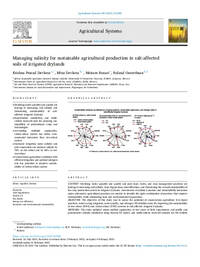Managing salinity for sustainable agricultural production in salt-affected soils of irrigated drylands

Authors:
CONTEXT
Declining water quantity and quality and poor land, water, and crop management practices are leading to increasing soil salinity, land degradation, desertification, and threatening the overall sustainability of the crop production system in irrigated drylands. Assessments of salinity dynamics and sustainability indicators under alternative agricultural practices are needed to identify the right combination of practices that improve sustainability while minimizing land and environmental degradation.
OBJECTIVE
The objective of this study was to assess the potential of conservation agriculture (CA)-based practices, water-saving irrigation, water quality, and nitrogen (N) fertilizer rates for improving the sustainability of rice-wheat (RWS) and cotton-wheat (CWS) systems in salt-affected irrigated drylands.
METHODS
The study included mixed-method approaches of two years of field experiments, soil profile and groundwater salinity simulation using Hydrus-1D model, and multi-criteria trade-off analysis for the holistic assessment of alternative innovations in RWS and CWS. The treatments in experiments were composed of a combination of CA-based practices, water-saving irrigation and N rates. Fourteen sustainability indicators computed from experiments and simulation were compared to evaluate the sustainability of those cropping systems and to reveal the potential of those practices for improving sustainability.
RESULTS AND CONCLUSIONS
Compared to the initial conditions, the soil salinity decreased in both cropping systems, while the reduction rate was much higher in RWS than CWS (by 28%). In RWS, the conventional treatment had the lowest salinity level, while in CWS, CA (permeant bed + residue retention) had the lowest. RWS raised the groundwater table by 25% compared to CWS. The long-term scenario analysis with Hydrus-1D demonstrated that, with increased irrigation water salinity and soil evaporation rates, soil profile salinity increases by 78% in RWS and 66% in CWS. RWS had a higher net profit (+81%) and soil organic carbon (SOC) (-15%), but lower water productivity (WP) (−147%), nitrogen, and energy use efficiency (EUE) (−46%) than CWS. The CA-based practices in CWS improved sustainability indicators with higher yield and net profit (+20%), WP (+26%), SOC (+456%), and EUE (36%) with decreased soil salinity than in the conventional system.
